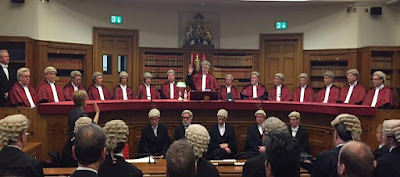 Farmer shot himself in 2012 after Lord Gill ruled landowners Human Rights breached. TENANT farmers continue to fight eviction from their farms after Lord Brian Gill ruled in 2012 that landowners human rights were breached by legislation aimed at protecting tenant farmers passed by the Scottish Parliament.
Farmer shot himself in 2012 after Lord Gill ruled landowners Human Rights breached. TENANT farmers continue to fight eviction from their farms after Lord Brian Gill ruled in 2012 that landowners human rights were breached by legislation aimed at protecting tenant farmers passed by the Scottish Parliament.
This week, another eviction of a tenant farmer has been reported where a petition attracted over 19,000 signatures backing Andrew Stoddart, of Colstoun Mains Farm, Haddington, who is fighting eviction by his landlord - the Colstoun Trust
Mr Stoddart and his young family have been told they have to leave by November 28, with the trust claiming it wants to have “greater involvement in the running of the farm”.
The Stoddarts, along with the two workers they employ on the 900-acre arable and sheep farm, will have to leave their homes and livelihoods behind. This would also be without compensation for the investment they have made.
The eviction follows a ten-year dispute over a rent review requested by Mr Stoddart.
It is worth remembering how these evictions have come about.
The quest by Landowners to eject tenants from land was made all the more easy by Scotland’s own landed gentry at the Court of Session after another ten year legal battle - which saw Lord Brian Gill rule in favour of landowners ‘Human Rights’ in 2012.
In the upheld appeal, senior judge Lord Gill ruled that measures put in place to protect tenants in such areas were not compatible with the European Convention on Human Rights.
Lord Gill’s ruling in Salvesen v Riddell [2012] CSIH 26, 2012 SLT 633 allowed billionaire landlord Alistair Salvesen to evict tenant farmer Andrew Riddell (52) from land his family had farmed for 100 years.
After the ruling from the Court of Session, it was widely reported in the media Mr Riddell committed suicide. He was found dead after he had harvested his final crop.
The father of four killed himself just weeks before he was due to leave Peaston Farm, near Ormiston, East Lothian.
Andrew had been involved in a 10-year court battle with his landlord, Scotland’s third richest man Alastair Salvesen.
Mr Riddell's battle began in 2003 when he was given notice to quit by landowner Alastair Salvesen, who bought the farm in 1998.
The problem stemmed from an outdated law that left the family few rights despite being on the land since 1902.
Salvesen served notice to the farmer after a ruling from Lord Gill and the judiciary enforced a notice for the farmer to quit.
The ruling overturned Mr Riddell’s previous security of tenure award in 2010 that meant he could stay living on the land.
Speaking in 2012 after the suicide of Mr Riddell, his neighbour and close friend George Mudie, 60, said: “The farm was Andrew’s life. He was affected very badly by the court’s decision.”
Lord Gill: The Landowner
Records now show at the time of Lord Justice Clerk Lord Gill’s ruling against tenant farmer Andrew Riddell, Lord Gill owned or had an interest in several properties, among them - a large Victorian mansion in one of the richest parts of Edinburgh.
The mansion – owned by the top judge was put on the market last year for £1.7m just before the independence referendum in 2014.
Gill also declared in his now publicly available register of Scottish Court Service Board interests he owns or holds property interests in London identified by an entry in the SCS Board register as “Vestry Court Ltd” –which leads to a multi million pound property listing in London.
Documents at Companies house list Lord Gill and his wife as holding interests in “Vestry Court Ltd” dating back to the mid 1990’s.

